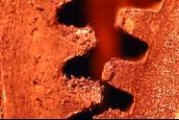![]()
![]()
Corrosion is the destructive attack of a material by reaction with its environment. The serious consequences of the corrosion process have become a problem of worldwide significance. In addition to our everyday encounters with this form of degradation, corrosion causes plant shutdowns, waste of valuable resources, loss or contamination of product, reduction in efficiency, costly maintenance, and expensive overdesign. It can also jeopardize safety and inhibit technological progress. |
Step 1 iron + oxygen --> iron oxide
Step 2 iron oxide + water --> hydrated iron oxide (rust)
Corrosion is the atmospheric oxidation of metals. That means that oxygen combines with the metal and forms a new layer. This layer can be good or bad. By far the most important form of corrosion is the rusting of iron and steel. Rusting is a process of oxidation in which iron combines with water and oxygen to form rust, the reddish-brown crust that forms on the surface of the iron. Because iron is so widely used, e.g., in building construction and in tools, its protection against rusting is important. Rusting can be prevented by excluding air and water from the iron surface, e.g., by painting, oiling, or greasing, or by plating the iron with a protective coating of another metal. Many alloys of iron are resistant to corrosion. Stainless steels are alloys of iron with such metals as chromium and nickel; they do not corrode because the added metals help form a hard, adherent oxide coating that resists further attack. |
 |
Although metals like aluminum, chromium, and zinc corrode more readily than iron, their oxides form a coating that protects the metal from further attack. Rust is brittle and flakes off the surface of the iron, continually exposing a fresh surface. Thus these metals might be a better selection choice for a product that will be exposed to rusting conditions, like water and air. |
Recognizing the symptoms and mechanism of a corrosion problem is an important preliminary step on the road to finding a convenient solution. There are basically five methods of corrosion control:
|